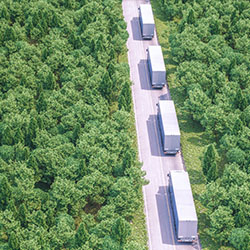Electronic Communication, Radars Make Platooning Work

Truck platooning technology, which will increase fuel efficiency and decrease emissions, is advancing rapidly. Vehicle manufacturers and tech companies continue to invest in the technology.
In truck platooning, connectivity, vehicle-to-vehicle communication and automated driving improves fuel efficiency by closing the distances between the connected trucks. Through the use of radar, cameras and reflective light scanning, tractor-trailers can travel at a distance of 30 to 50 feet.
By traveling closer to the vehicle in front of it, a tractor-trailer can save 10 percent on fuel. Plus, the truck in front also burns about five percent less fuel, the Washington Post reported. “Part of the drag on a truck plowing into the wind is caused by turbulent air that tumbles off the top and sides of the trailer. When two trucks pair up closely, the air flows more smoothly from the first to the second, reducing that turbulence,” the Post reported.
Drivers remain in the cab to steer and take control if necessary, but the technology links acceleration and braking directly to the engine controls, which allows the vehicles to adjust speeds and automatically brake, bypassing the driver when two trucks are paired. That automatic communication can increase safety because it decreases reaction time.
Both Navistar and Daimler said they have plans to test platooning technology and the Silicon Valley startup, Peloton Technology, is working with several truck makers, including Volvo, on its platooning system.
How Platooning Works at a Glance
Truck platooning is the linking of two or more trucks in convoy, using connectivity technology, engine communications and automated driving systems to allow vehicles to travel closer together.
Forward-Looking Camera
Cameras can capture and relay the view from the first truck to a screen in the following trucks.
Radar-Based Collision Mitigation
The use of a radar-based collision mitigation system can detect obstacles in the road further out than a human driver can reliably see. Plus, when the front truck slows, the trailing truck can apply the brakes.
Acceleration and Braking Controller
If the lead truck speeds up or engages its brakes, the trailing truck will as well.
Vehicle-to-Vehicle Communication
An onboard computer is connected to a vehicle-to-vehicle communications device that receives and transmits data using dedicated short-range communications.
GPS
GPS data is used to help connect tractors in a platoon.
Cellular & Wi-Fi Communication
Tractors share information with each other using cellular and Wi-Fi communications.

The lead truck controls the linked vehicles behind it through on-board technology, engine controls and multiple sensors.
Trailing vehicle-to-vehicle communication between the trucks allows them to share information and improves reaction times.
April 2018

